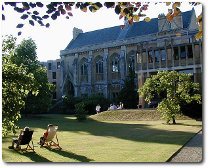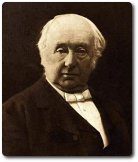Hopkins - Oxford and Conversion
Gerard Manley Hopkins - Life at Balliol
At the end of 1862, Hopkins won an exhibition (or scholarship) to Balliol College, one of the colleges of Oxford University. He began  studying there in the April of 1863. His main course of study, lasting four years, was in Humanities (or Literae Humaniores, to give the course its full title), and consisted of:
studying there in the April of 1863. His main course of study, lasting four years, was in Humanities (or Literae Humaniores, to give the course its full title), and consisted of:
- the study of Latin and Greek
- some history, philosophy and logic
- religious education.
Hopkins really enjoyed Oxford life, writing a considerable amount of poetry, and studying art, perhaps with the idea of becoming an artist-poet. He had excellent teachers there, including:
- T.H.Green, one of the leading philosophers of the day
- Benjamin Jowett, a theologian and Greek scholar with some unorthodox ideas
- Walter Pater, a well-known literary critic and writer on aesthetics (the study of the beautiful).
Hopkins turned out to be an excellent student and at his degree exams gained a ‘double first’, the highest classification possible.
Hopkins's changing religious outlook
When Hopkins arrived at university, he was a devout and committed High Church Anglican. He even started to go to confession, which was not at all obligatory for Anglicans, though it was for Roman Catholics.
The Oxford Movement
Oxford was the centre of belief and practice of the Oxford Movement, especially under its leading theologians, Edward Pusey, Professor of Hebrew, and John Keble. However, several leading Oxford High Church Anglicans had become Roman Catholics, including John Henry Newman. The shock waves caused by these moves were still subsiding when Hopkins came to Oxford.
Hopkins’ doubts
Hopkins was essentially an idealist, and as he read some of the debate about these issues, he became  increasingly convinced that the Church of England was a compromise between Catholicism on the one hand, and fully fledged Protestantism on the other- a compromise that he found it difficult to hold on to logically. He also seems to have been attracted to several Catholic teachings, especially the doctrine of transubstantiation which is concerned with the meaning of Communion or Mass, the central act of Christian worship. High Church Anglicanism was not just losing the battle with the Catholics, but also with the Latitudinarians, led by Benjamin Jowett. Hopkins began to question his own attitude to Anglicanism.
increasingly convinced that the Church of England was a compromise between Catholicism on the one hand, and fully fledged Protestantism on the other- a compromise that he found it difficult to hold on to logically. He also seems to have been attracted to several Catholic teachings, especially the doctrine of transubstantiation which is concerned with the meaning of Communion or Mass, the central act of Christian worship. High Church Anglicanism was not just losing the battle with the Catholics, but also with the Latitudinarians, led by Benjamin Jowett. Hopkins began to question his own attitude to Anglicanism.
The repercussions of change
In these days, it is difficult to imagine the cost of conversion from Anglicanism to Roman Catholicism. To most people to-day, it might seem no more significant than choosing which supermarket to shop at. At the time, however, it was as significant as changing from one religion to another might be today, an action which can still bring rejection by one’s family or community.
This was the risk Hopkins was running when, in July 1866, he decided to enter the Roman Catholic church. He was so afraid of what his family would think that he delayed telling them till the very last moment.
They were deeply shocked. His father asked Hopkins’ Anglican mentor to persuade him against such a move. In the end, he accepted Hopkins back into the family, though only under the condition he did not try to convert his brothers and sisters.
Hopkins' new direction
Hopkins had been helped greatly in his conversion by John Henry Newman, who was based in Birmingham, at the Oratory Church, which he had founded. When Hopkins graduated, he went to the Oratory School to do some teaching.
Whilst there, he felt a real urge to become a priest. He could have trained to become a parish priest, but instead became attracted to the Jesuits, or the Society of Jesus as they are officially called. This meant becoming part of a religious order, living in highly disciplined semi-monastic conditions during and after a long training, and being sent wherever the Order chose.
Members of the Anglican Church who emphasise continuity with Catholic tradition without accepting all the teachings of the Roman Catholic church.
The Anglican church is the 'Established' or state church of England, the result of a break with the Catholic church under Henry VIII and further developments in the reign of Elizabeth I.
1. The part of a service of Christian worship where people say sorry to God for not living according to his will.
2. The practice of privately telling a priest of wrongdoing.
Member of a worldwide Christian church which traces its origins from St. Peter, one of Jesus' original disciples. It has a continuous history from earliest Christianity.
A Christian movement in the mid-nineteenth century on the part of some Anglicans to revive Catholic practices in the Church of England. It was centred on Oxford University.
The 'Established' or state church of England, the result of a break with the Catholic church under Henry VIII and further developments in the reign of Elizabeth I.
Used as a general term, describes Christian groups which accept the ancient creeds such as the Orthodox, Roman Catholic and Anglican churches.
Christians whose faith and practice stems from the Reformation movement in the sixteenth century which resulted in new churches being created as an alternative to the Roman Catholic Church.
The conversion of bread and wine into the body and blood of Christ which is believed by some Christians to occur in the Eucharist or Mass.
The central act of Christian worship in which bread and wine are consumed in the way that Jesus demonstrated at the Last Supper before his betrayal and death.
The central religious service of the Roman Catholic Church, incorporating praise, intercession and readings from scripture. The central action is the consecration of the bread and wine by the priest.
The older name for that branch of the Church of England that adopted liberal or modernist views.
A person whose role is to carry out religious functions.
Area with its own church, served by a priest who has the spiritual care of all those living within it.
An order within the Roman Catholic church, founded by St. Ignatius Loyola, and known as the Society of Jesus. They are an active order, serving as priests, missionaries, and teachers.
The name given to the man believed by Christians to be the Son of God. Also given the title Christ, meaning 'anointed one' or Messiah. His life is recorded most fully in the Four Gospels.
A religious order is a group of men or of women who have taken vows to live a religious life in a certain way, usually by living, worshipping and working together.
The monastic movement consists of communities of monks. Communal life was built around prayer, the opus dei or work of God.
A religious order is a group of men or of women who have taken vows to live a religious life in a certain way, usually by living, worshipping and working together.
 studying there in the April of 1863. His main course of study, lasting four years, was in Humanities (or Literae Humaniores, to give the course its full title), and consisted of:
studying there in the April of 1863. His main course of study, lasting four years, was in Humanities (or Literae Humaniores, to give the course its full title), and consisted of:
